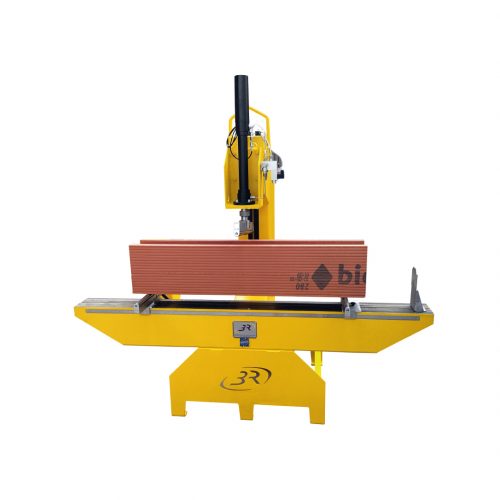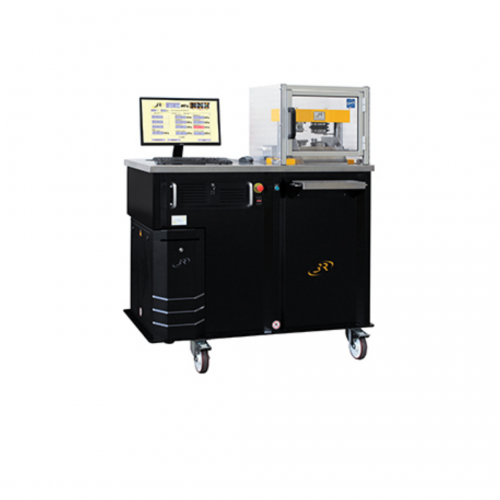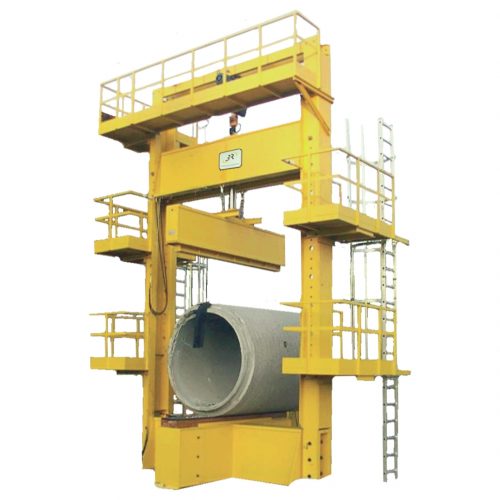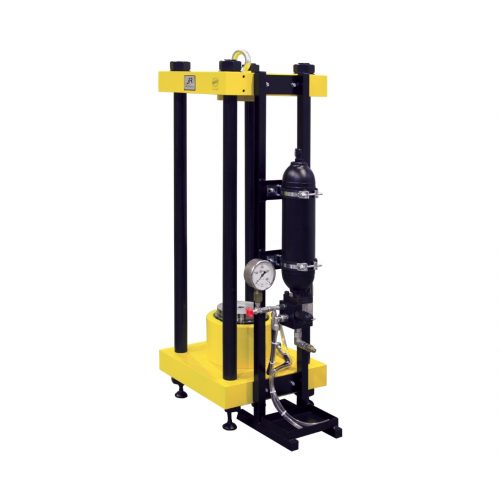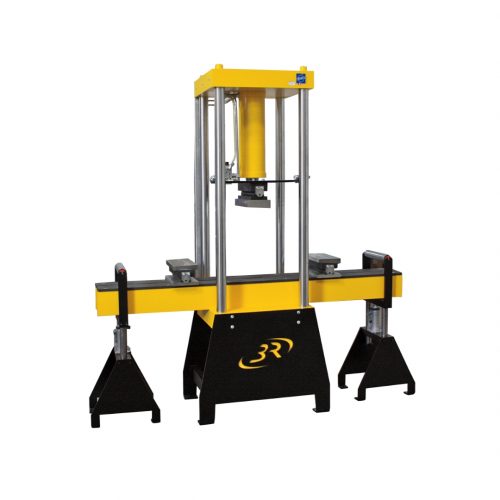Testing Machines
Concrete compression testing machines: how to make the right choice?
Today, the compression equipment market offers a very wide range of machines. With such a wide and diversified range, the choice can be bewildering for the customer, who is not necessarily a specialist. How to make the best compromise between price, performance and ergonomics?
How to choose a compression frame?
Concrete is more and more technical material and the pursuit for ever increasing strenght continues every day. Modern needs bring out two tendencies : on the one hand, the need to control standard concrete resistance so that concrete professionals can sell products adapted to different uses (resistance vs cost ratio) and on the other hand, the desire to build more and more imposing structures forces the big manufacturers in this sector to develop very high performance concretes.
In this context, the proficiency of concrete mechanical characteristics is a problem for today and and for the future. The testing machine is the main assessment element for mechanical resistance. It defines itself by many criteria of which the main are:
Maximum force
Obviously your testing needs vary; however, it is better not to regularly use the machine at above 75% of its maximum force capacity.
Operating
Most of the machines are hydraulic. They operate either by flow control or by pressure control. Both technologies are equivalent for testing rigid materials, but the latter one is simpler and more stable over time.
Maximum pressure
The higher the pressure is, the smallerer the bore of the hydraulic jack. Therefore, frame dimensions are reduced resulting in reduced material and hence weight. On the other hand, the higher the pressure is, the more the oil is compressed and stores energy. This energy will be restituted during the rupture of the specimen. In doing so, the electric motor is more stressed, causing excessive heating and lamination of the hydraulic oil, reducing performance over time.
Weight
Weight is not a decision factore, per se, because it depends on the conception of the machine but it gives a good idea about its robustness and its durability. As a rule, the heavier the frame, less it will distort, and the better it will run over time.
Rigidity
Axial rigidity is the maximum force of the machine divided by deformation at this load. It is expressed in kN/mm and is normally inferior to 1 for good machines. A very rigid machine is a guarantee of durability. If deformation under load is high, the energy restituted during fragile rupture on highly breakable materials (bricks, high performances concretes …) will result in a premature ageing of some pieces like the ball joint, the plates and the jack. Transverse rigidity is seldom given and yet it is very important in order to ensure pertinent results. The standard NF EN 12390-4 stipulates alignment controls under load and the value of the transverse rigidity is decisive to meeting its requirements.
The jack
The jack is the main piece of the compression frame, because it is the oil pressure inside the jack that helps to measure the force applied to the specimen. It is therefore important that there is as little friction as possible. For this, the jack must have a sufficient guidance (most of time at least 1 times the piston diameter). This guidance guarantees the alignment of the pressure center, and prevents any risk of wedging of the piston in case of excessive output. Joints must also be of very high quality and low friction.
Structure
Machines are either mechanically welded or manufactured (2, 3 or 4 columns).
-
-
- Mechanically welded or manufactured ?The advantage of mechanically welded constructions is its attractive price. On the other hand, the constraints created by welds can damage the alignment of the pressure center. These machines generally have weakness of rigidity transverse.
Manufactured machines need a big accuracy of the adjustments in order to avoid any movement under load at assemblies’ level. A realization of quality and a tightening appropriated will guarantee a perfect geometry and the durability of characteristics. - How many columns?Two column machines can offer a good access to the tests chamber and are economical. However the transverse rigidity on a front/back vertical position is critical when columns are not oversized.
Three column machines are ideal. Three support points ensure the best balance. The structure is isostatic and the transverse rigidity is homogeneous whatever its direction is. The only weak point is they hardly go along with large-sized plates, for block tests for instance. They are ideal for tests on cylindrical or cubic specimen.
The four column machines offer a good compromise: a uniforme transverse rigidity and the possibility of using big plates. Hyperstatic aspect of its structure must be offset by a good manufacturing accuracy.
- Mechanically welded or manufactured ?The advantage of mechanically welded constructions is its attractive price. On the other hand, the constraints created by welds can damage the alignment of the pressure center. These machines generally have weakness of rigidity transverse.
-
Ergonomics
This is an essential element to improve comfort and efficiency from the laboratory assistant into his daily work.
The working height must be adapted.
The change of specimen types must be done easily and quickly. When one shifts from a big size specimen to a small size one, you need to add wedges on or under the lower plate. One should limit the mass of the manipulated elements and make sure their setting up is easy. Likewise a stacking up of wedges can lead to a faulty alignment and so decreased the breaking strength. A long power jack avoid any manipulation.
After the test, some wreckage can be thrown out. The cleaning work of the assistant laboratory is limited when the wreckage is inside the compression chamber. Likewise, drainage of channeled wreckage (drop sides, ramp, wreckage container…), makes the assistant laboratory work easier and reduces the test time.
Safety devices must necessarily minimally limit the work area access and not reduce the operator tasks.
To choose a compression machine, all these criterions need to be estimated in order to find a better compromise adapted to its own use. From his side, the constructor must offer machines with the best value for money.
The company 3R, armed with its experience, made its machines without limiting them at the normative requirements but by improving every point that could lead to a results drop and by bringing a lot of attention to ergonomics for the assistant laboratory work and watching over for the final cost.
3R suggests 2 machines, following the analysis of all these criterions that meet your need in an optimum way. If you only test specimen (cubes or cylinders), the ideal machine is certainly the 3000 TCT which combines the best characteristics: exceptional rigidity (4280 kN/mm = 0.7 mm at 3000 kN), long power jack (100mm) and long driving, big diameter ball joint on steel, etc…
But if your need to test a bigger range of samples as cubes, cylinders, blocks or bricks, so the best compromise will be the RP 2000 QC/LC or the RP 3000 QC/LC, which have the most efficient and rational technical criterions, summed up in some figures below:
-
-
- 200 mm: Jack power to test very different kind of specimens, as cubes 15 x 15 or 20 x 20, cylinders 11 x 22, 15 x 30 or 16 x 32, blocks 20 x 20 x 50 or 25 x 25 x 50, bricks from all sizes without addiction of wedges.
- 980 mm : Height of the lower plate thanks to which the user can manipulate the specimen ergonomically without needing to bend over, and so expose himself to dreadful RSI (Repetitive Strain Injury).
- 310 x 510 mm: Plate dimensions to test blocks and bricks up to 500 mm long and 300 mm wide. Optional, the QC/LC can be equipped with 610 mm long plates (and even 410 mm wide on the 3000 kN).
- 2980 kN/mm: Frame rigidity (0.7 mm in full load for the 2000) and 4110 kN/mm for the 3000 kN
- 400 bar: Maximum testing pressure of the hydraulic system in full load that limits the system wear and the energy stored into the oil.
-
3R machines range is not limited to these 2 models. Over the years 3R had been led up to develop either cost-effective machines to be used by construction site laboratories as top of the range machines (up to 5000 kN) to be used by research laboratories.


